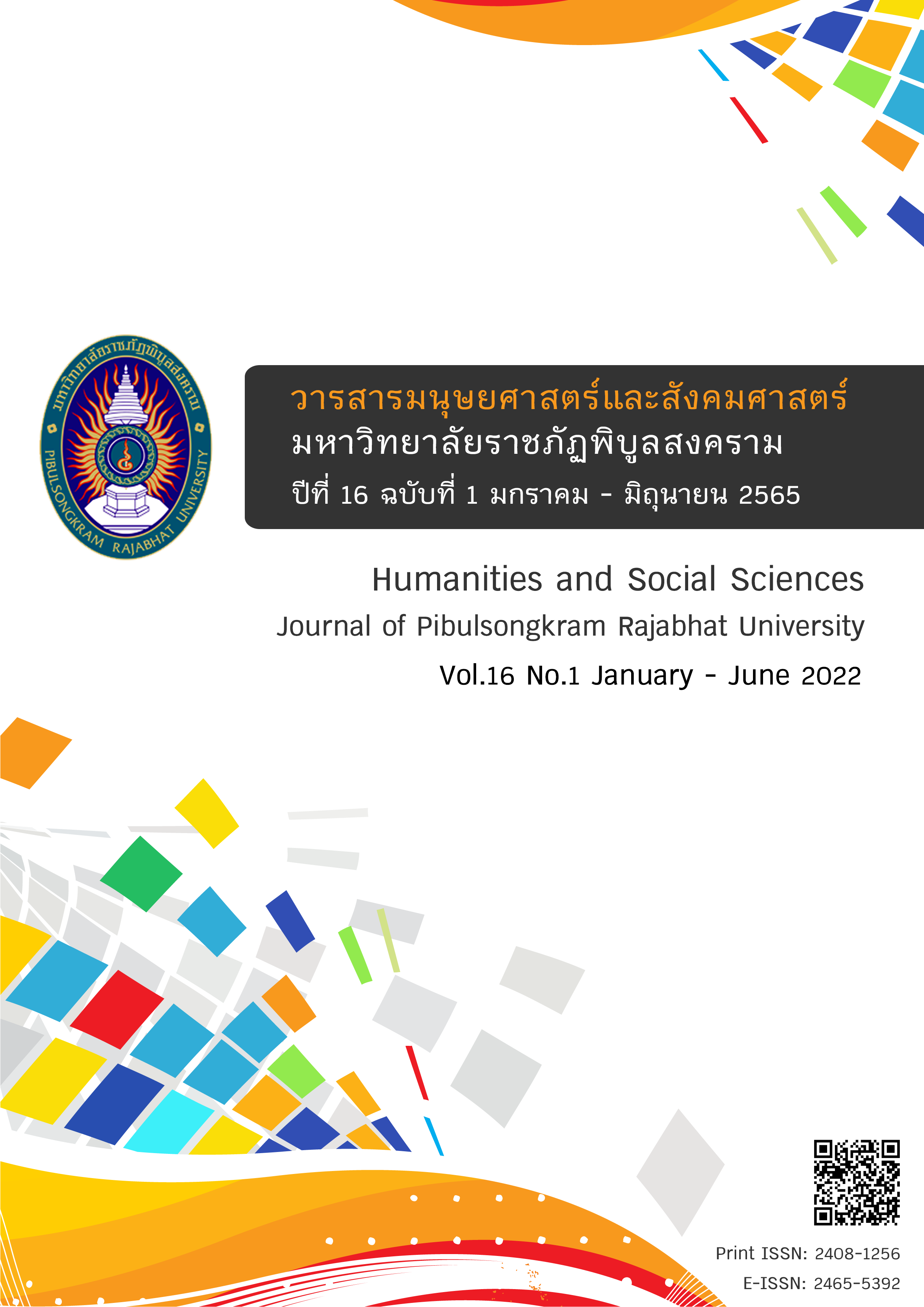แนวทางการพัฒนาศักยภาพการวิจัยด้านการศึกษาของนักศึกษา คณะครุศาสตร์ มหาวิทยาลัยราชภัฏภูเก็ต
DOI:
https://doi.org/10.14456/psruhss.2022.9คำสำคัญ:
ศักยภาพการวิจัย , การวิจัยด้านการศึกษาบทคัดย่อ
วัตถุประสงค์ของการวิจัยครั้งนี้ เพื่อพัฒนาศักยภาพการวิจัยด้านการศึกษาของนักศึกษาชั้นปีที่ 4-5 คณะครุศาสตร์ มหาวิทยาลัยราชภัฏภูเก็ต กลุ่มตัวอย่างการวิจัย คือ นักศึกษาคณะครุศาสตร์ ชั้นปีที่ 4-5 จำนวน 300 คน และผู้สอนหรือที่ปรึกษาการวิจัยให้กับนักศึกษาคณะครุศาสตร์ จำนวน 10 คน เครื่องมือที่ใช้ในการวิจัยคือ แบบสอบถามและการสัมภาษณ์ วิเคราะห์ข้อมูลด้วยค่าเฉลี่ยและการวิเคราะห์เชิงเนื้อหาส่วนเบี่ยงเบนมาตรฐาน ผลการวิจัยพบว่า (1) นักศึกษามีความรู้เกี่ยวกับการวิจัยด้านการศึกษาอยู่ในระดับน้อย (2) มีทักษะเกี่ยวกับการวิจัยด้านการศึกษาอยู่ในระดับมาก และมีผลสัมฤทธิ์ทางการศึกษา ได้เกรด A จำนวน 122 คน
คิดเป็นร้อยละ 40.67 และ (3) มีเจตคติเกี่ยวกับการวิจัยด้านการศึกษาอยู่ในระดับมาก โดยสามารถพัฒนาศักยภาพการวิจัยด้านการศึกษาของนักศึกษาด้วยการฝึกอบรมเพื่อพัฒนาศักยภาพการวิจัย นอกเหนือจากการจัดการเรียนการสอนในห้องเรียนและการได้ลงมือปฏิบัติการวิจัยด้วยตนเองของนักศึกษาแล้ว หน่วยงานต้องมีการกำหนดแนวทางการฝึกอบรมเพื่อพัฒนาศักยภาพการวิจัยให้นักศึกษาอย่างสม่ำเสมอ โดยเชิญวิทยากรที่มีผลงานวิจัยโดดเด่นหรือเป็นที่ยอมรับในศาสตร์นั้น ๆ มาให้ความรู้เพิ่มเติมแก่นักศึกษา โดยมีหัวข้อการฝึกอบรมที่สำคัญ ได้แก่ (1) ฝึกกระบวนการคิด เช่น การคิดเป็นระบบ การคิดเชิงวิทยาศาสตร์ การคิดเชิงสร้างสรรค์
(2) ฝึกการสร้างโจทย์วิจัย (3) ฝึกการสื่อสาร พูด อ่าน เขียน (ไทย/อังกฤษ) (4) ฝึกเสนอผลงาน (ไทย/อังกฤษ) (5) ฝึกการเขียนบทความทางวิชาการ (6) ฝึกการทำงานเป็นทีม การทำงานร่วมกับพี่เลี้ยง (7) สร้างทัศนคติที่จำเป็น และ (8) กิจกรรมการจัดการความรู้ (Knowledge Management: KM) ซึ่งการฝึกอบรมดังกล่าวจะช่วยให้นักศึกษาเกิดการพัฒนาศักยภาพเพิ่มขึ้นจากความรู้พื้นฐานที่ได้รับในห้องเรียน แนวทางการพัฒนาศักยภาพการวิจัยด้านการศึกษาของนักศึกษาคณะครุศาสตร์ มหาวิทยาลัยราชภัฏภูเก็ต อันดับแรกคือ ความรู้เกี่ยวกับการวิจัย รองลงมาคือ เจตคติต่อการวิจัย และสุดท้ายคือ ทักษะการวิจัย ซึ่งควรปรับปรุงด้วยการจัดการเรียนการสอนที่เน้นผู้เรียนเป็นสำคัญ ให้นักศึกษาเรียนรู้ในสิ่งที่ตนอยากรู้ โดยผู้สอนคอยปลูกฝังเจตคติที่ดีต่อการวิจัยโดยมุ่งเน้นที่คุณค่าและประโยชน์ที่ได้รับจากการวิจัย และให้เรียนรู้ผ่านการปฏิบัติการวิจัยด้วยตนเองมากขึ้นอันเป็นการฝึกทักษะการวิจัยได้อย่างดี โดยมีผู้สอนเป็นคนกำหนดขอบเขตและระยะเวลา นอกจากนั้นผู้สอนต้องมีการบูรณาการข้ามศาสตร์เพื่อให้นักศึกษาเกิดการพัฒนาศักยภาพการวิจัยให้ดียิ่งขึ้น
เอกสารอ้างอิง
กาญจนา ตระกูลวรกุล. (2548). อิทธิพลของปัจจัยเกี่ยวกับลักษณะครูและการวิจัยปฏิบัติการของครูที่มีต่อโอกาสการเพิ่มสมรรถภาพการวิจัย (วิทยานิพนธ์ปริญญามหาบัณฑิต). กรุงเทพฯ: จุฬาลงกรณ์มหาวิทยาลัย.
โชติกา ภาษีผล. (2559). การวัดและการประเมินผลการเรียนรู้. กรุงเทพฯ: จุฬาลงกรณ์มหาวิทยาลัย.
ทิพวรรณ ภัทรนุสรณ์. (2556). อิทธิพลของการเสริมพลังอำนาจครูที่มีต่อผลผลิตของการวิจัยปฏิบัติการในชั้นเรียนผ่านสมรรถนะการวิจัยปฏิบัติการในชั้นเรียน (วิทยานิพนธ์ปริญญามหาบัณฑิต). กรุงเทพฯ: จุฬาลงกรณ์มหาวิทยาลัย.
ทิศนา แขมมณี. (2559). ศาสตร์การสอน: องค์ความรู้เพื่อการจัดกระบวนการเรียนรู้ที่มีประสิทธิภาพ (พิมพ์ครั้งที่ 20). กรุงเทพฯ: จุฬาลงกรณ์มหาวิทยาลัย.
นิรชรา ไชยแสง, และศศิธร ดลปัดชา. (2555). ความพึงพอใจความผาสุกของบุคลากรคณะศึกษาศาสตร์ ประจำปีการศึกษา 2554 (รายงานการวิจัย). ขอนแก่น: มหาวิทยาลัยขอนแก่น.
ประกาศ เรื่อง ยุทธศาสตร์ชาติ (พ.ศ. 2561-2580). (2561, 13 ตุลาคม). ราชกิจจานุเบกษา. เล่ม 135 ตอนที่ 82 ก. หน้า 1-71.
ประสาท เนืองเฉลิม. (2561). วิจัยปฏิบัติการทางการเรียนการสอน. ขอนแก่น: คลังนานาวิทยา.
ประเสริฐ เรือนนะการ, และฐิติยา เรือนนะการ. (2561). การพัฒนาศักยภาพด้านการวิจัยของครูโรงเรียนกระบากวิทยาคาร จังหวัดมหาสารคาม. วารสารศึกษาศาสตร์ มหาวิทยาลัยมหาสารคาม, 12(3), 295-308.
ยุพิน กองรักษา. (2552). พฤติกรรมของครูนักวิจัย: พหุกรณีศึกษาของครูนักวิจัยในจังหวัดศรีสะเกษ (วิทยานิพนธ์ปริญญามหาบัณฑิต). มหาสารคาม: มหาวิทยาลัยมหาสารคาม.
รวิรัตน์ โสธรพิทักษ์กุล. (2557). รูปแบบการประยุกต์งานวิจัยเพื่อการบริหารโรงเรียน (ปริญญานิพนธ์ปรัชญาดุษฎีบัณฑิต). นครปฐม: มหาวิทยาลัยศิลปากร.
วรรณะ บรรจง. (2554). เอกลักษณ์ครูนักวิจัย: ความต่อเนื่องในการพัฒนา. วารสารวิชาการศิลปศาสตร์ประยุกต์, 4(2), 71-81.
วลัยรัตน์ สุวรรณชัยรบ. (2558). การพัฒนาศักยภาพการทำวิจัยในชั้นเรียนของครูโรงเรียนบ้านอูนดง สังกัดสำนักงานเขตพื้นที่การศึกษาประถมศึกษาสกลนคร เขต 2 (วิทยานิพนธ์ปริญญามหาบัณฑิต). สกลนคร: มหาวิทยาลัยราชภัฏสกลนคร.
วิไลวรรณ จันน้ำใส. (2555). ปัจจัยที่สัมพันธ์กับสมรรถนะการวิจัยในชั้นเรียนของครู สังกัดสำนักงานเขตพื้นที่การศึกษามัธยมศึกษา เขต 30 (วิทยานิพนธ์ปริญญามหาบัณฑิต). ปทุมธานี: มหาวิทยาลัยเทคโนโลยีราชมงคลธัญบุรี.
สำนักงานเลขาธิการสภาการศึกษา. (2559). รายงานการวิจัยแนวโน้มภาพอนาคตการศึกษาและการเรียนรู้ของไทยในปี พ.ศ. 2573. กรุงเทพฯ: 21 เซ็นจูรี่.
สำนักงานสถิติแห่งชาติ. (ม.ป.ป.). เทคนิคการสุ่มตัวอย่างและการประมาณค่า. กรุงเทพฯ: สำนักงานฯ.
สุภางค์ จันทวานิช. (2554). วิธีการวิจัยเชิงคุณภาพ (พิมพ์ครั้งที่ 19). กรุงเทพฯ: จุฬาลงกรณ์มหาวิทยาลัย.
อรอุมา รุ่งเรืองวณิชกุล. (2556). การพัฒนารูปแบบการเสริมสร้างสมรรถนะครูนักวิจัยด้วยการบูรณาการกระบวนการเรียนรู้ สำหรับข้าราชการครู สังกัดสำนักงานเขตพื้นที่การศึกษามัธยมศึกษา เขต 2 (วิทยานิพนธ์ปริญญาดุษฎีบัณฑิต). กรุงเทพฯ: มหาวิทยาลัยศรีนครินทรวิโรฒ.
อุดมพร ทองคำ. (2555). การวิจัยเชิงปฏิบัติการเพื่อพัฒนาศักยภาพการทำวิจัยในชั้นเรียนของครูโรงเรียนส่องดาววิทยาคม สังกัดสำนักงานเขตพื้นที่การศึกษา มัธยมศึกษา เขต 23 (วิทยานิพนธ์ปริญญามหาบัณฑิต). สกลนคร: มหาวิทยาลัยราชภัฏสกลนคร.
Gagnon, G. W., & Collay, M. (2001). Designing for learning: Six elements in constructivist classrooms. California: Corwin Press.
Yamane, T. (1973). Statistic: An introduction analysis (3rd ed.). New York: Harper & Row.
ดาวน์โหลด
เผยแพร่แล้ว
รูปแบบการอ้างอิง
ฉบับ
ประเภทบทความ
สัญญาอนุญาต
ลิขสิทธิ์ (c) 2020 วารสารมนุษยศาสตร์และสังคมศาสตร์ มหาวิทยาลัยราชภัฏพิบูลสงคราม

อนุญาตภายใต้เงื่อนไข Creative Commons Attribution-NonCommercial-NoDerivatives 4.0 International License.
บทความหรือข้อคิดเห็นใดใดที่ปรากฏในวารสารมนุษยศาสตร์และสังคมศาสตร์ มหาวิทยาลัยราชภัฏพิบูลสงครามเป็นวรรณกรรมของผู้เขียน ซึ่งบรรณาธิการไม่จำเป็นต้องเห็นด้วย บทความที่ได้รับการตีพิมพ์เป็นลิขสิทธิ์ของวารสารมนุษยศาสตร์และสังคมศาสตร์ มหาวิทยาลัยราชภัฏพิบูลสงคราม









